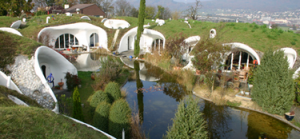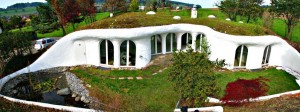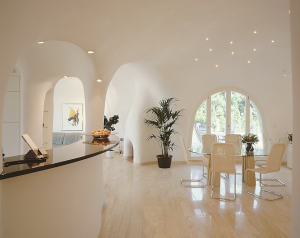If you’ve ever wanted to “not to live under or in the ground, but with it”, then here’s the neighbourhood for you: architect Peter Vetsch’s ‘Earth House’ development located in Switzerland. After looking through a few photos of the developments, one could argue that the ‘Earth House’ development is a true Garden City… in the literal sense.
Clearly, the idea of living in harmony with nature (or a tamed version of it) has been of central importance to several urban planners throughout the years. Thus the ‘Earth House’ is especially interesting when compared to urban planning schemes and utopian fantasies of the past century. Unsurprisingly, the fixation on natural light, green space, ventilation, space for recreation, and affordability remain central concerns for architects and urban planners. It is with these factors, coupled with the modern day preoccupation of environmental consciousness and ecological concerns, that Vetsch has created a new sustainable settlement. This new development consists of single-family homes covered by a blanket of earth and grass and surrounding an artificial lake in Dietikon Switzerland.
Vetsch focuses on promoting his unique style of architecture as environmentally friendly and financially savvy, two major concerns today. In recent years there has been an especially decisive shift towards environmental sustainability, and the ‘Earth House’ is the epitome of this movement. The ‘Earth House’ is surrounded by ground, which acts as insulation to keep the heating costs low while still protecting dwellers from adverse weather conditions. Vetsch designs these unique developments to preserve the natural landscape and he moulds each house according to the environment. This allows for organic arches to characterize the interior of the home; creating an environment highly effective for insulation that can result in energy savings up to 50%! Moreover, this unique structure also allows for a plethora of natural light in several rooms.
The ground enveloping the home also acts as a cocoon to protect it from rain, wind, and abrasion. According to Vetsch, these homes are also very well protected from earthquakes, fire hazards, and severe windstorms due to the fact that they’re built into, opposed to on top, of the ground. This may provide additional reassurance to some as we navigate the unpredictable terrain of climate change. Finally, the ‘Earth House’ also provides ample room for green space as the ‘roof’ of the home can be used as a gardening space or a terrace.
I personally think the idea is fascinating, environmentally conscious, and whimsical. I love the idea of having an environmentally friendly home focused on renewable energy as an option in a society that’s growing at an unprecedented rate. Having said that, I can see how it wouldn’t appeal to everybody considering that it’s clearly not conducive to city living. What are your thoughts on this style of development?




Beautiful! It’s like if Gaudi designed the Shire.
Very cool! The Shire was my first thought as well – any chance Vetsch is a massive Lord of the Rings fan? 🙂
But seriously, I think this is a very unique concept. Very environmentally friendly, and very appealing for those who wish to live ‘closer to nature’. The use of rooftops as gardens or terraces was particularly ingenious to me – and it is all natural!
However, I would see this type of development as being very specific to certain areas and tastes, and would not work just anywhere. It seems much more ‘European’ in style and design, and I honestly can’t see too much interest for it among the general North American public. In addition, as you mentioned, it would only work in rural settings.
Personally, I wouldn’t want to live in one of these all the time, but it would be a cool vacation spot!
I thought your description of the ‘Earth House’ as whimsical to be apt. The concept is definitely visually appealing, but little else. I can’t imagine how the Earth House could be financially viable at all. The architect designs each ‘House’ uniquely to its topographic plot. I can imagine a future where the world’s affluent will live in these ‘Earth Houses’ telling anyone who will listen how they are helping the environment.